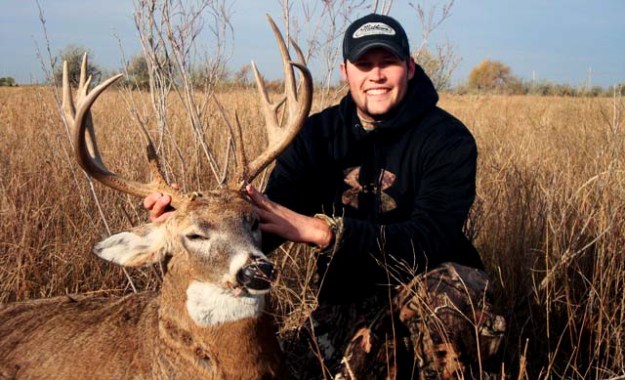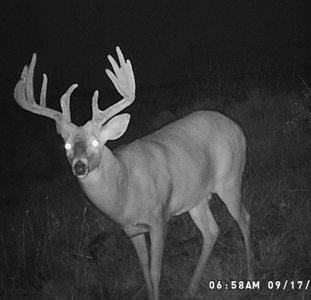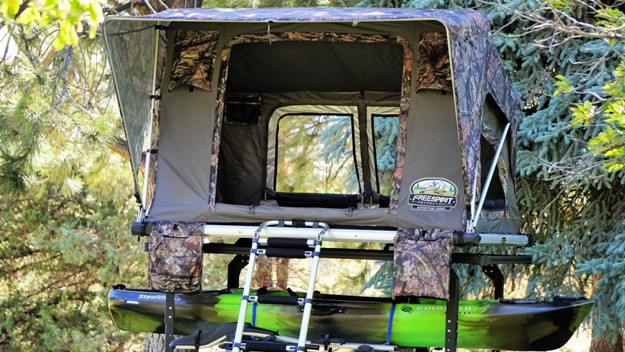
In Kansas, a resident hunter either can take a white-tailed buck or a mule deer buck. If you draw an imaginary line through the center of Kansas and decide to hunt west of that center line, you’ll have really good mule deer hunting and whitetail hunting. What’s made this area even better is there’s an abundance of public walking areas for hunting. One of the reasons this section of Kansas probably doesn’t get as much deer hunting pressure as the eastern part of the state is because there are very few trees in the western region. A hunter who comes from out-of-state will look at this section and say, “There are no or very few trees on this side of the state, so deer can’t live there.” However, plenty of deer do live in the western side of Kansas.
To take either a Kansas mule deer or a whitetail, the best tactic is to spot-and-stalk, and not hunt from a tree stand or a ground blind. The two secrets for taking deer successfully in this part of Kansas is to find cover and water. Getting in-between the deer’s water source and food source will help hunters be successful in taking mule deer and whitetails. The easiest way to scout this region before you hunt it is to study Google Earth maps, and/or use the onX Hunt Maps system, look too at with landowners’ names and the walking hunting areas clearly marked, so you can find them with a hand-held GPS receiver or on your SmartPhone. Also you’ll find quite a bit of Conservation Reserve Program (CRP) land. The deer use these areas for feeding and bedding.
My honey hole is a 3,000-acre woodlot that family members and our guests hunt. I’m hunting deer that have some hunting pressure, but the hunting pressure is not nearly as heavy as you find on public-hunting lands. In Kansas, we legally can bait, so I start putting out corn 2-3 months before deer season. However, I’m not trying to lure in deer to the corn. I use the corn to stop deer close enough to my bow stand to allow me to take a shot. Even if you’re hunting in a state where baiting is not legal during hunting season, you can put feed out before the season and remove it a certain number of days before hunting season begins. Then this same technique may work for you.
 I start at the beginning of the summer, glassing agricultural fields. Once I spot big bucks, I start to scout that field to learn where the bigger bucks enter and leave the field. Next I go in and search for trails that the bucks are using to go to and from the field. Remember, during the summer months, the bucks will be bedding fairly close to their food source, because the weather is so hot - even at night - that they don’t want to travel far from the food. That’s why I rarely walk close to the trail for more than 50-100 yards, because I don’t want spook the buck I’m trying to take. Next I look for a place to put a ladder stand between the deer’s bedding site and the food source. I’ll set-up a trail camera right under the stand and put corn around the spot where I want the buck to stop and feed before he goes to his food source, or after he comes out of an agricultural field, just before daylight.
I start at the beginning of the summer, glassing agricultural fields. Once I spot big bucks, I start to scout that field to learn where the bigger bucks enter and leave the field. Next I go in and search for trails that the bucks are using to go to and from the field. Remember, during the summer months, the bucks will be bedding fairly close to their food source, because the weather is so hot - even at night - that they don’t want to travel far from the food. That’s why I rarely walk close to the trail for more than 50-100 yards, because I don’t want spook the buck I’m trying to take. Next I look for a place to put a ladder stand between the deer’s bedding site and the food source. I’ll set-up a trail camera right under the stand and put corn around the spot where I want the buck to stop and feed before he goes to his food source, or after he comes out of an agricultural field, just before daylight.
One of the deer’s favorite foods in my region is soybeans, and during the summer months, the soybeans offer a lush green feeding spot for whitetails. They also feed in alfalfa fields and milo fields. These three main crops are what the whitetails in my section of Kansas seem to target the most.
Before I put boots on the ground, I start studying Google Earth maps, and I often can pinpoint where I think the deer are bedding. I want to set-up my stand and my trail camera in-between the fields where they’re feeding and the place where they’re bedding in a spot where I’m least likely to spook an older-age-class deer, when I go to check my camera or move in to hunt. I use my trail cameras to gather information on the bucks that have survived after hunting season. Since we only can take one buck per season, I target my hunting efforts on the biggest buck I’ve identified. I put out 15-trail cameras each year during the summer. One time I could have taken the biggest buck on this property each year for 3 years that I’d identified, however, I let that buck walk and didn’t harvest him until the 4th year when he scored 193 Boone & Crockett points.
Day 1: Ryan Koelsch Starts Bowhunting Big Bucks and Selling Real Estate
Tomorrow: Ryan Koelsch Passes Up a 170 Buck for Three Years




























